Trump could have easily insisted on a more substantial attack against the Syrian regime last weekend. His decision not to do so underscored the underlying import of the missiles he had dispatched and the message that he meant to accompany them. That message amounts to a Trump Doctrine for the Middle East, writes Martin Indyk. This piece originally appeared in The Atlantic.
The evening of Friday, April 13th, 2018, was John Bolton’s debut crisis as President Trump’s national-security adviser. Barely three days on the job and there he was, standing off-camera in the White House Diplomatic Reception Room, while his new boss delivered an address to the nation to explain why U.S., British, and French aircraft and missiles were attacking targets associated with Syria’s chemical-weapons program.
Trump read from a teleprompter, standing in front of a portrait of George Washington, flanked at each shoulder by a small bronze statue of an American eagle with its wings raised and an arrangement of yellow and white roses. The symbolism was of an assertive White House in spring bloom. As his boss delivered what sounded like a carefully negotiated script, Bolton studied a copy of Trump’s remarks with gel pen poised as if to check whether he remained true to his text.
To be sure, there were a few classic Trumpisms in the president’s delivery: Assad as a “monster,” the American economy as the “greatest and most powerful…in the history of the world,” and Trump’s wistful ever-present hope that “someday we will get along with Russia.”
But the real message of the address was far more restrained than Trump or his national-security adviser reportedly desired. A chemical weapons R&D center and two storage facilities were destroyed to degrade—not eliminate—Assad’s capabilities and send a signal that the United States and its Western allies would not tolerate the use of these weapons of mass destruction. No other regime targets were struck, no Syrian aircraft destroyed, no Russian or Iranian bases threatened, and no Russian air-defense zone penetrated. It was, as Defense Secretary James Mattis described it afterward, “a one-time shot.” No doubt at another time, under another president, Trump and Bolton would have accurately described it as a “pin-prick attack.”
As commander-in-chief, with Bolton at his side to bolster his belligerent instincts, Trump could have easily insisted on a more substantial attack. His decision not to do so underscored the underlying import of the missiles he had dispatched and the message that he meant to accompany them. That message was the real lead that Trump buried in his Friday the 13th Address. And it amounts to a Trump Doctrine for the Middle East.
Trump could have easily insisted on a more substantial attack.
“We cannot purge the world of evil or act everywhere there is tyranny,” Trump averred, in stark contrast to John F. Kennedy’s “pay any price, bear any burden…to assure the survival and the success of liberty.” Instead, Trump was intent on downplaying expectations and limiting U.S. engagement: “No amount of American blood or treasure can produce lasting peace and security in the Middle East. It’s a troubled place,” he declared. Trump promised to “try to make it better,” but he repeated: “It is a troubled place.”
Like “Crooked Hillary,” “Liddle Marco,” “Lyin’ Ted,” and “Leakin’ Comey,” the Middle East has now been Trump-branded as “a troubled place.” Clearly not somewhere for a great-again-America to invest its energy. By his use of American force, Trump intended to establish a strong deterrent against Assad’s use of chemical weapons, because he declared it to be “a vital national security interest of the United States.” But, this vital interest would remain narrowly defined. By contrast, “the fate of the region,” he explained, “lies in the hands of its own people.”
The Middle East has now been Trump-branded as “a troubled place.”
In other words, there would be no effort to overthrow Assad, or any other Middle Eastern tyrant. To protect the American people, Trump would complete the destruction of ISIS in Syria, “with but a small force.” It would, however, be up to America’s regional friends to “ensure that Iran does not profit from the eradication of ISIS.” Indeed, Trump elaborated, “we have asked our partners to take greater responsibility for securing their home region.” So much for the United States taking the lead in rolling back Iran’s hegemonic gains in the Middle East, as Trump’s scathing criticism of the Iran nuclear deal had implied. Trump has in effect now declared that in the Middle East he will, just like his archrival Obama, lead from behind.
Critics of Trump who argue that the strike on Syrian chemical weapons facilities needs to be part of a broader strategy seem to be deaf to this message, perhaps imagining they can goad him into adopting a more ambitious effort to remake Syria or the broader region in America’s image. But Trump already has a Middle East strategy. It’s just not the one they, and possibly Bolton, would prefer. He will embrace America’s Middle East partners, autocrats and democrats alike, and sell them all the arms they can afford. But it’s their job to assume the burdens of dealing with this troubled place, not his.
If Assad dares to use chemical weapons again, Trump made clear he’ll bomb again. But if Assad wants to continue slaughtering his people with conventional weapons, it’s up to others to deal with him. Listen up: “The fate of the region lies in the hands of its own people,” not in Trump’s hands.
His intent to leave Syria to its own devices was something Trump clearly signaled when he declared on March 29 that American troops would be departing there “very soon.” “Let other people take care of it,” he told a rally of his supporters in Ohio, foreshadowing his more detailed remarks on Friday night.
 But he had already made clear his intentions in Syria, or lack of them, over the past year when he repeatedly avoided helping Israel, America’s closest Middle Eastern ally, contain Iran’s encroachments there. Prime Minister Benjamin Netanyahu has tried repeatedly to enlist Trump’s aid in establishing red lines in Syria against Iran’s establishment there of an air base, factories for precision-guided rockets for delivery to Hezbollah, and encroachment of the Golan Heights by Iranian-backed militias. Instead, Netanyahu has had to travel seven times to Moscow to beseech Putin for the help he could not secure from Trump. But absent Trump’s engagement, Putin has no interest in challenging his Iranian partner in Assad’s reconquest of rebel-controlled territories. Bibi’s appeals therefore fell on Putin’s deaf ears.
But he had already made clear his intentions in Syria, or lack of them, over the past year when he repeatedly avoided helping Israel, America’s closest Middle Eastern ally, contain Iran’s encroachments there. Prime Minister Benjamin Netanyahu has tried repeatedly to enlist Trump’s aid in establishing red lines in Syria against Iran’s establishment there of an air base, factories for precision-guided rockets for delivery to Hezbollah, and encroachment of the Golan Heights by Iranian-backed militias. Instead, Netanyahu has had to travel seven times to Moscow to beseech Putin for the help he could not secure from Trump. But absent Trump’s engagement, Putin has no interest in challenging his Iranian partner in Assad’s reconquest of rebel-controlled territories. Bibi’s appeals therefore fell on Putin’s deaf ears.
This has left Israel to enforce its own red lines by attacking Iranian facilities and convoys. Now Tehran’s promises of retaliation are ratcheting up tensions and an all-out confrontation is looming, one that could engulf Lebanon too. Should that happen, Trump can be counted on to cheer Israel from the sidelines as the troubled place becomes predictably even more troubled.
Similarly, in Yemen, Trump is happy to help his friend Saudi Crown Prince Mohammed bin Salman flail around in the quagmire, providing all the weapons and intelligence he can use. But there has been and will be no U.S. diplomatic engagement to promote a political settlement that might help Saudi Arabia forge a much-needed exit strategy and end the humanitarian crisis. And who benefits in the meantime? Iran, of course, which by supplying rockets to Houthi rebels is building its position of influence on Saudi Arabia’s southern border for barely any cost to itself.
We should not imagine that John Bolton is going to change any of this. Perhaps he wanted a more robust attack. Perhaps he wanted to provoke a confrontation with Russia. But his checking of Trump’s text against delivery in the Diplomatic Reception Room is a picture that tells a thousand words. He was making sure the Trump Doctrine for disengagement from the Middle East was accurately delivered.
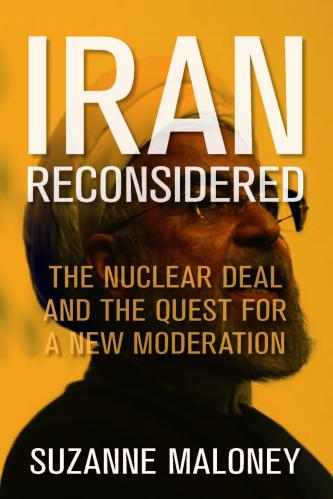

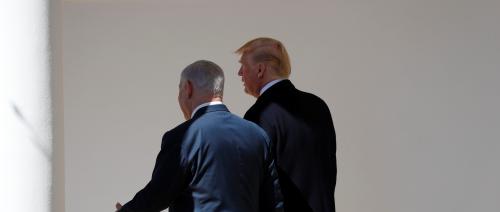
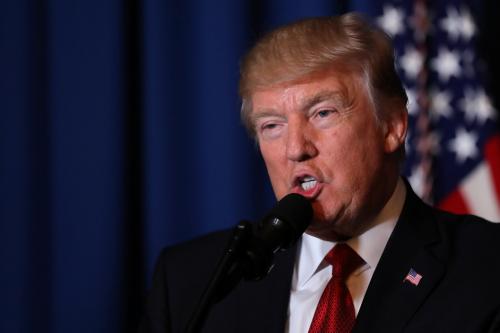
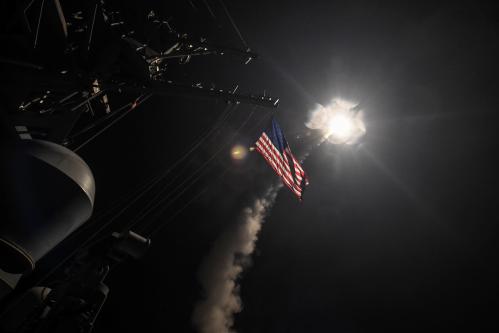
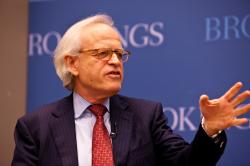

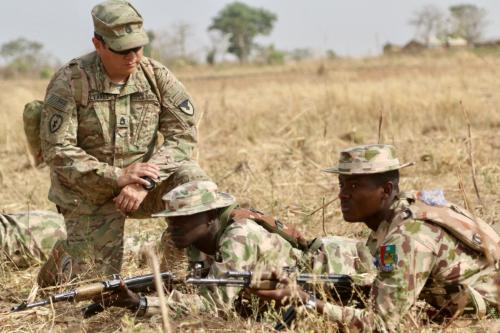
Commentary
A Trump doctrine for the Middle East
April 16, 2018